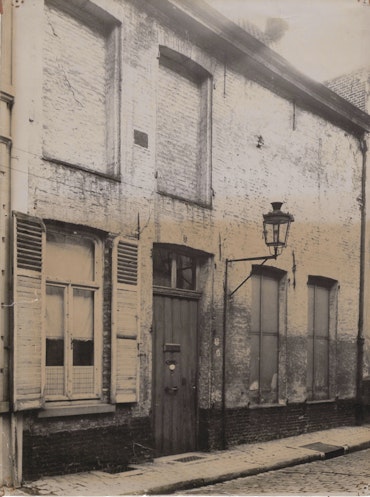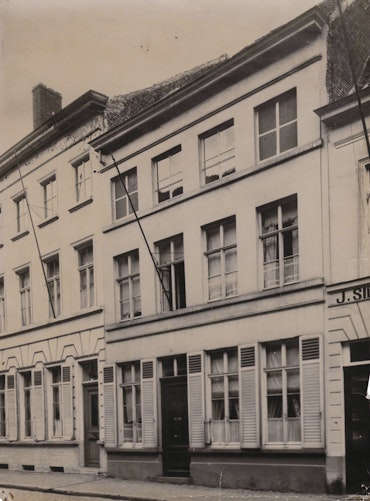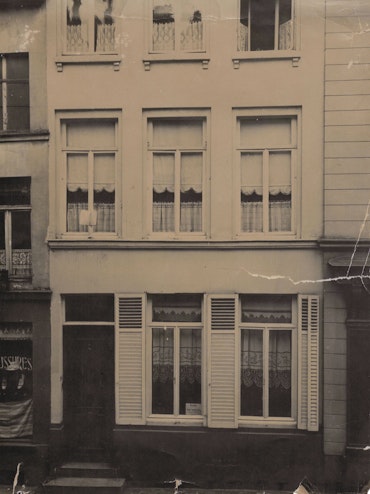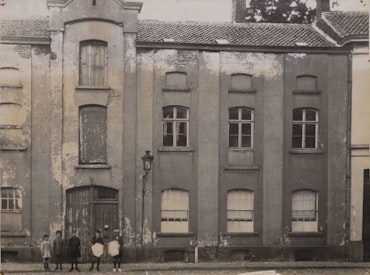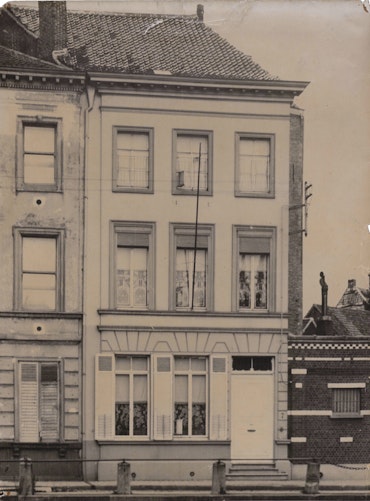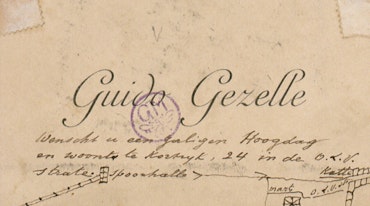

Assistant Priest (1872-1889)
In 1872 Gezelle was transferred to the Our Lady’s parish in Courtrai. There he had several places of residence : in the Handboogstraat, the Reepstraat 7, Groeningestraat 28 and Onze-Lieve-Vrouwestraat 24.
Gezelle's Houses in Courtrai
 Poem by Gezelle Two dickybirds so cute, for the factory girls.
Poem by Gezelle Two dickybirds so cute, for the factory girls.
Journalist and Occasional Poet
He remained active in various fields, as a parish priest, as an orator and as a political journalist for the Gazette van Kortrijk. He also fought for the foundation of a “Davidsfonds” section in Courtrai, thus contributing to the city’s Flemish-catholic emancipation. Supported by a circle of mostly well-to-do friends he there became the occasional poet par excellence. From 1875 on he was the spiritual director of a group of factory girls called the Katrientjes, for whom he wrote quite a lot of poems. He did the same for the Francophone Our Lady’s congregation of the Sisters of Saint Vincentius a Paulo, under his care since 1879.
 One of the Word-Stack boxes containing part of Gezelle’s Word Stack
One of the Word-Stack boxes containing part of Gezelle’s Word Stack
Poetry
Step by step Gezelle returned to his former, religiously inspired interest in popular language and in poetry. He started his Word Stack, a gigantic collection of words taken down from popular speech, and the periodical Loquela (1881). By doing so he defended the Southern Netherlandic language within the development of a standardized Dutch cultural language.

 Postcard from J. Fové to Guido Gezelle about Flemish words
Postcard from J. Fové to Guido Gezelle about Flemish words
Ear Gleaners
He was given practical assistance by his secretary Cordelia Van de Wiele, as well as by an elaborate network of so-called “zanters” (ear gleaners) who sent him their linguistic findings from local dialects. Also northern France and Friesland were in his field of interest.
 Royal Flemish Academy of Philology and Literature in Ghent.
Royal Flemish Academy of Philology and Literature in Ghent.
The Royal Flemish Academy
His philological activities brought Gezelle to a renewed attention for his own creative work, both in original poetry and in translating poetry (Longfellow’s Hiawatha). Finally he gained recognition for all his work. For example, in 1886 he was nominated member of the newly founded Royal Flemish Academy of Philology and Literature.
Convent Director (1889-1893) and Officeless (1893-1899)
In 1889 Gezelle became the director of a minor French sister congregation that settled down in Courtrai -quite an easy job for him-, and from 1893 on he was even without office. This gave him the opportunity to concentrate intensively upon writing and studying.
 Gezelle in 1893
Gezelle in 1893
Nature Poetry
Gezelle was the moving force behind the foundation of the periodical Biekorf (Beehive) and wrote two voluminous collections of poems, Tijdkrans (Wreath of Time) (1893) and Rijmsnoer (Garland of Rhyme) (1897), the latter especially of superior graphic design and originality. In the meantime, Gezelle’s refined and complex idiom was enriched by linguistic material which he had been collecting all his life until then, through research in ancient written literature from the Netherlands, and in contemporary oral Flemish dialects. In numerous realistic and impressionistic nature poems he realizes sound harmonies with an expressive symbolic function.
 Poetry manuscript of The angry booming clouds are full of unearthly flurries from Wreath of time.
Poetry manuscript of The angry booming clouds are full of unearthly flurries from Wreath of time.
 Hugo Verriest
Hugo Verriest
Future Influences
This genuine and original lyrical poetry made H. Verriest, Pol De Mont and Van Nu en Straks in the first place, consider him as a precursor of modern Dutch poetry. Subsequent poets such as Paul van Ostaijen and, more recently, Christine D’haen, also honoured Gezelle as the most creative and innovative Dutch poet of Flanders.
